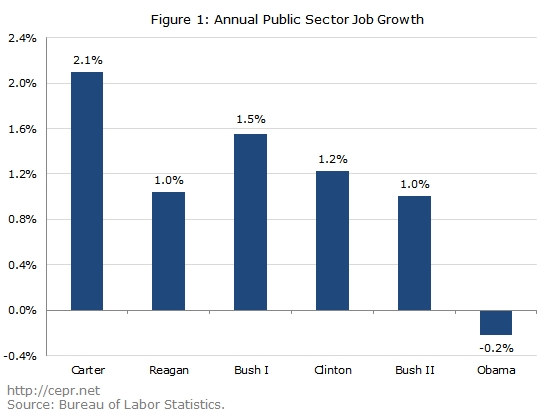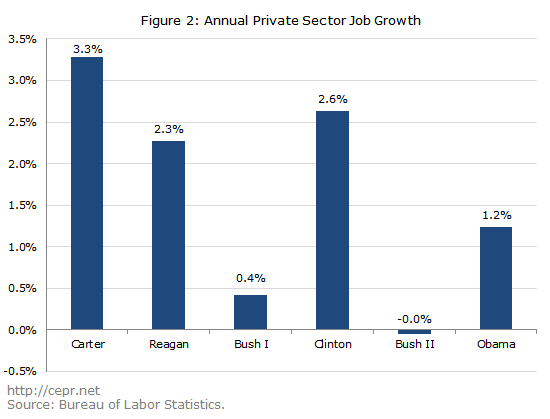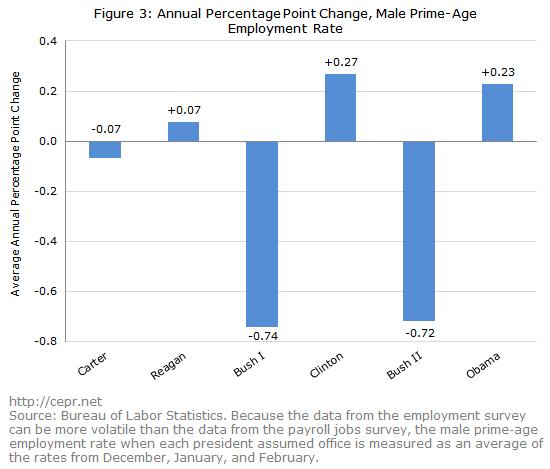September 26, 2016
Paul Krugman recently wrote an interesting blog post titled “The Curious Confidence of Charlatans and Cranks” Krugman starts off with an interesting graph showing the total number of private sector payroll jobs gained or lost under each U.S. president from Jimmy Carter to Barack Obama.
While this metric is informative, it is imperfect in at least two ways. First,a president’s track record on jobs will depend to a significant degree on his total time spent in office. Fortunately, it is easy to correct for this problem all we need to do is look at the average change in jobs per year. Second, the total number of jobs gained is an imprecise metric, given that at least part of the differences between time periods can be attributed to different rates of population growth. An easy way of correcting for this is to measure the percent change in the total number of jobs. Therefore the best metric for comparing different presidents’ track records would be the average annual percent change in jobs.
Before going any further, though, it’s worth dispelling at least one common trope about job growth under Democratic presidents, particularly President Obama. (Note that Krugman does not make this error in his blog, and in fact has called out politicians who have made this error themselves.) It is not the case that Democrats are only able to achieve solid job growth because they hand out government jobs. In fact, as shown in Figure 1 below, public-sector job growth has actually been negative under President Obama. Moreover, public-sector employment has on average gone up more under the last three Republican presidents (1.1 percent per year) than under the last three Democratic presidents (0.8 percent per year).

So let’s turn our attention to private-sector job growth. Whereas government employment tends to grow more quickly under Republican presidents, private-sector employment seems to rise faster under Democratic ones. Private-sector employment actually declined under the second President Bush, and it rose at just a 0.4 percent annual rate for his father. Reagan had a better track record than either of the two more recent Republican presidents, but even his track record is weaker than the rates of growth posted under Carter and Clinton.

Furthermore, it should be noted that Figure 2 understates the economic improvements made under one president in particular: Barack Obama. When Obama first assumed office in January 2009, involuntary part-time employment was nearlypercent of total employmentt’s down to percent today. This means that about three million workers previously stuck in part-time jobs have been able to find full-time positions since Obama got into office. Because these workers did not gain jobs they were already employed, albeit at insufficient hours improvements in their working hours do not show up in the statistics on job growth.
Finally, straight-up comparisons of job growth miss out on the effects of changing demographics. Because Obama has been faced with an aging population in a way that other presidents haven’t, many more Americans have opted for retirement during his presidency. This reflects the changing preferences of an older population, not weakness in the labor market.
A comparison that controls for changing demographics is shown below. Figure 3 shows the average annual percentage-point change in the male prime-age employment rate for each of the last six presidents. (The analysis is restricted to men since rising rates of employment for women primarily reflect changing social norms rather than changes in the cyclical strength of the economy.) By this measure, Obama’s track record looks much better. Even with a negative rate of government job growth, the change in prime-age employment under President Obama has been better than under Reagan, Carter, and both President Bush. (There is also an important reversal for Jimmy Carter, whose track record appears far less impressive in Figure 3 than in Figure 2.)

Because the data from the employment survey can be more volatile than the data from the payroll jobs survey, the male prime-age employment rate when each president assumed office is measured as an average of the rates from December, January, and February.
So President Obama specifically and Democrats more generally seem to have a pretty strong record on private-sector job growth. Figure 4 below compares the average rates of private- and public-sector job growth under Democratic versus Republican presidents. Since 1977, private-sector job growth has been more than twice as strong under Democrats as under Republicans. If “handing out government jobs” is meant to describe one political party’s job creation strategy, it clearly isn’t the Democratic Party.







